BenQ X2200W 22in LCD Monitor Review
BenQ X2200W 22in LCD Monitor
BenQ goes after gamers with this premium 22in LCD that boasts HDMI, DVI and D-SUB inputs and PerfectMotion technology.
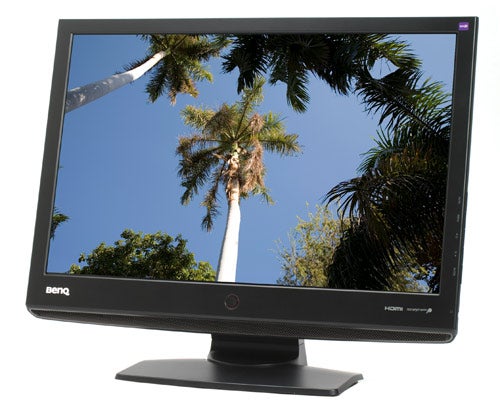
Verdict
Key Specifications
- Review Price: £299.00
Reviewing and buying LCD monitors can be a minefield at the best of times. Look back a year or two and things appeared fairly straightforward. If you wanted to play games but had a limited budget then any TN Film based panel was your best bet, offering fast and responsive displays at often very attractive prices. However, these displays sacrificed colour fidelity by using 6-bit panels with “dithering” that produced only 16.2million colours compared to the 16.7million of genuine 8-bit panels, thus making them unsuitable for any colour intensive work, or for anyone with especially discerning tastes.
This made the S-PVA based screens like the legendary Samsung SyncMaster 215TW much sought after, especially since viewing angles on TN Film displays were also distinctly underwhelming. However, whereas then the divide between the good and the bad, the virtuous and the evil, was very clear, now things aren’t so clear cut. With TN Film based screens becoming more common and of better quality, some manufacturers are even marketing recent models as premium consumer products, combining both decent colour production and the high responsiveness that’s often attractive to gamers. 
We’ve already seen this to mixed success with the likes of the LG Flatron L227WT-PF and BenQ has joined in this trend with its new X Series 1,680 x 1,050 22in LCD, the X2200W. Retailing for £299 inc. VAT when it launches BenQ is targeting gamers, with the screen initially coming bundled with a pair of Sennheiser PC 161s, the non-USB version of the excellent Sennheiser PC 166 USB Headset. So, though £300 may sound like an awful lot for a display of this type, the headphones are an added value benefit. Is it enough though?
What else will you get for the money? Well, unusually for a 22in LCD this model comes with both HDMI and DVI along with the ubiquitous D-SUB input. This means you can happily connect both a PC and a console, be it PS3 or Xbox 360 Elite, via digital connections and still have one input more to play with. Indeed, perhaps the ideal combination would be PC via DVI, PS3 via HDMI and an Xbox 360 via the D-SUB and though the lack of component inputs means the likes of the Wii are excluded, realistically two consoles and a PC in the bedroom is as about as many as you’d want.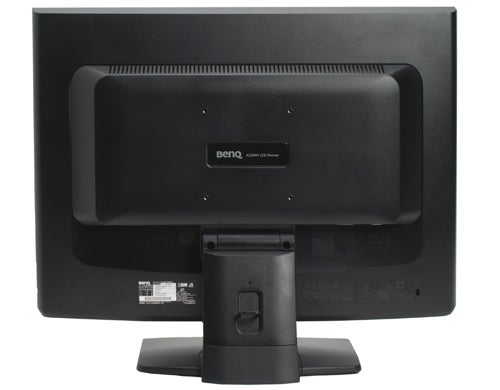
Vitally, the included HDMI port also transmits audio, both to speakers via a 3.5mm audio output on the back and a headphone jack housed on the right outside edge of the display. This is, you’ll probably agree, all very good, but though there’s no shortage of audio outputs there’s also no separate audio input. This poses a problem if one wants to use an Xbox 360 via D-SUB, since you’ll still have to find alternative means for connecting the audio. It’s a shame BenQ didn’t think to add RCA audio inputs or a 3.5mm input as well, since this really would have made the X2200W an even more convenient gaming solution.
As it is, though, you’ll have to do without and you’ll also have to do without any real adjustability, with no swivel base and only a standard level of tilt available. It’s a little frustrating, truth be told, to find a supposedly premium product lacking in such a basic department and though we’ve become quite accustomed to not seeing height adjustment on 22in LCDs, no swivel capability is somewhat galling.
Thankfully, the BenQ X2200W does make up for this in its styling. Housed in a graphite grey plastic casing similar to that of the Iiyama ProLite B2403WS, it instantly looks and feels classy, especially compared to the glossy but rather cheap feeling LG Flatron L227WT-PF. It has a nice slim bezel and OSD buttons are tucked away on the right edge, with only the power button on the front to interrupt the otherwise minimalist aesthetic.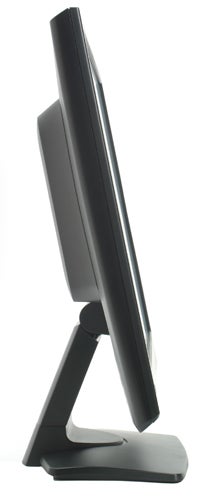
Speaking of the OSD, one can often tolerate poor OSDs if you seldom delve into them, but that doesn’t make it any less annoying when you’re confronted by a puzzling set of unintelligible symbols. No such problems exist here. BenQ’s OSD is attractive and easy to use, with a consistent navigation system aided by clear and easy to read labels for each OSD control button. It’s all very straightforward.
And, as you explore the OSD, you’ll discover a nice variety of options. Naturally, brightness and contrast controls are present, while you can adjust each colour setting individually. You can also use the colour presets of Bluish, Reddish and Normal and though we’d sooner see proper colour space options (i.e. 6500k, 9300k etc), it’s not an issue worth worrying about too much. Also accessible from the OSD are a selection of picture modes, which can also be selected directly via one of the OSD buttons.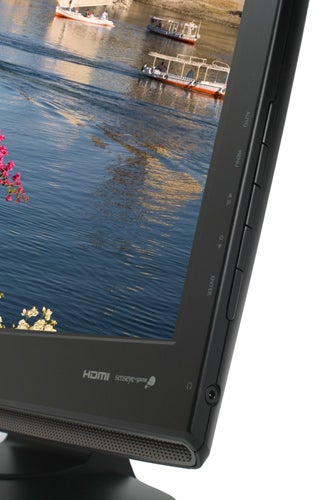
Your choice includes Movie, Dynamics, Photo, Action Game and Racing Game modes and though they exhibit clear differences, none provide a conclusive case of their worth. Movie mode does what is typical of most movie modes, boosting contrast and colours but creating a somewhat stilted image that’s not very attractive and lacks detail. Likewise, the Dynamics and Photo modes add similar effects at varying degrees of severity, without ever improving image quality to our eyes.
But, if the Movie, Dynamics and Photo modes are simply more of the same, the Action Game and Racing Game modes activate what BenQ calls PerfectMotion – a technology that’s “Pre-Programmed For Maximum Excitement” apparently. Marketing slogans aside, PerfectMotion is a combination of two different processes designed to improve motion perception. In fact, the first half of this technology is fairly ordinary since it’s an overdrive mode common among most TN Film displays; however, the second ingredient is far more interesting.
It’s known as Simulated Pulse Driving (SPD) and it uses a technique known as Black Frame Insertion (BFI) to essentially trick the eye by inserting black frames between the normal ones, creating smoother and less blurred motion that BenQ argues is more akin to a CRT. It’s not a claim we’re especially convinced by, but it’s undeniable that it does have an effect. You still get an element of afterglow that to an extent is unavoidable, but it definitely reduces the level of smearing present and makes for slightly smoother and more pleasing motion.
However, though this does work well enough, you’ll soon be put off by the fact that the extra black frames make the overall picture intolerably and irreversibly dark and murky. Thus, otherwise colourful and vibrant scenes look like they’ve been doused in several layers Los Angeles smog. It’s rather like a cure to the Common Cold that makes you partially blind, removing a tolerable annoyance but introducing something far less palatable. Some might be able to convince themselves otherwise, but they’ll be in the minority.
As for panel specifications, everything is as one would expect. The X2200W can produce the full 16.7 million colours, according to BenQ at least, it’s another to feature a wider 92 per cent colour gamut. And, while we’ve remained healthily sceptical about claims regarding colour production on TN Films screens, there’s some evidence to suggest these newer examples are indeed producing 16.7 million colours, albeit due to more advanced dithering techniques. A contrast ratio of 1,000:1 and brightness of 300cd/m2 are perfectly acceptable, while BenQ is good enough to quote both the typical response time of 5ms and the Motion Picture Response Time (MPRT) of 8ms.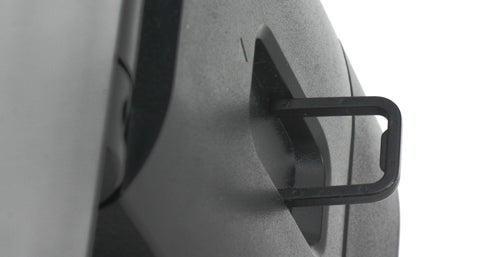
It also quotes the viewing angles, which are 160 degrees vertical and horizontal. Of all the aspects of the TN Film displays this is still the weakest, despite the fact that there’s been significant improvement. Overall, it means a noticeable loss of both brightness and contrast when viewing from an angle, though there’s none of the nasty colour distortion of old. For most, though, this won’t pose too great an issue.
On first use you’ll probably find the X2200W very bright. It’s a common facet of consumer monitors, which often arrive out of the box with excessively high brightness settings since manufacturers believe this to the best way to “wow” the customer straight away. It’s also very vibrant, which is another common occurrence where high colour gamut displays are concerned. Greens are the most noticeable in this respect and some may see the need to tone things down a little.
Once tweaked, though, we found the X2200W to be a very capable display. In DisplayMate it performed admirably, with good colour fidelity and gradation in the Colour Scales and very smooth gradients on the intensity tests with only the smallest hint of banding. A dark screen showed some minor light bleed from both the bottom and top edges, but nothing bad enough to truly affect the overall image. Unfortunately, though, despite advances these new TN Film panels still struggle in the Dark-Grey Scale, with compression on the dark end of the scale that suggests that detail in dark scenes will be a problem. This was repeated in the White-Level Saturation test, with compression on the brighter end of the scale.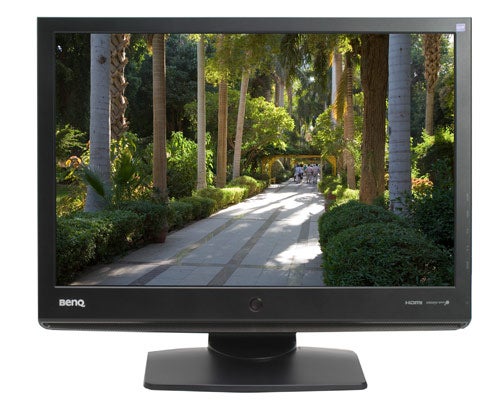
Still, these are synthetic tests and in general use these aspects won’t affect the majority of users. Video playback was good, with high definition content looking the part thanks to predominantly smooth motion, vibrant but not overwhelming colours and neutral skin tones. Much the same can be said of games and it ought to be noted these impressions are based on using normal settings, not any of the picture modes on offer. Black levels were also decent for LCD monitor, though the aforementioned lack of detail in dark scenes was evident.
Yet, despite this decent effort we can’t quite wholeheartedly recommend the X2200W. It has many good qualities, with a good selection of inputs and an attractive design. Indeed, had it boasted more adjustability and a more competitive price, it might have become more attractive. However, there are a few too many niggling doubts, which for a monitor in this price bracket isn’t ideal.
Even accepting the headphone offer and the fact that retailers will see fit to reduce the price over time, it’s a rather expensive monitor that doesn’t add enough tangible benefits to justify that price tag. And, when you consider that the 24in TN Film monitors like the Samsung SyncMaster 245B and the Iiyama ProLite B2403WS are available for the same price or less, it’s hard to argue the case for a smaller display with very good but not quite excellent image quality.
Verdict
We like the design, input selection and the bundled headphones don’t hurt either, but despite many good ingredients the BenQ X2200W doesn’t quite convince. Its PerfectMotion technology is of dubious value, while the price puts it right in the way of the juggernaut of bargain 1,920 x 1,200 24in monitors and it doesn’t quite offer the premium performance required to set it apart from them or the cheaper but more than capable 22in competition. This doesn’t make it a bad display by any means and in most respects it’s very good, but unless the bundled headphones are a major draw you’ll probably want to wait until it’s available for closer to £250 or so before taking the plunge.
Trusted Score
Score in detail
-
Image Quality 8
-
Value 7

